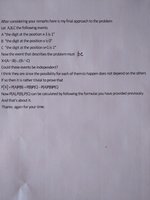Good Morning from Greece. I would very much appreciate if you could give a hand on this one:
Let it be a binary number with r digits produced by k "aces" and r-k "zeroes". How many such defferent binaries can be produced? And further more what is the possibility for a randomly selected "zero" digit of the binary to be next to an "ace" (it doesnt matter if the "ace" is left or right to the "zero")
Now , for small k and r , we can answer by constructing a tree or for greater numbers with just plug them in to a computer but i was wondering if there is a analytical solution to the problem
Thank you for your time in advance.
Let it be a binary number with r digits produced by k "aces" and r-k "zeroes". How many such defferent binaries can be produced? And further more what is the possibility for a randomly selected "zero" digit of the binary to be next to an "ace" (it doesnt matter if the "ace" is left or right to the "zero")
Now , for small k and r , we can answer by constructing a tree or for greater numbers with just plug them in to a computer but i was wondering if there is a analytical solution to the problem
Thank you for your time in advance.

